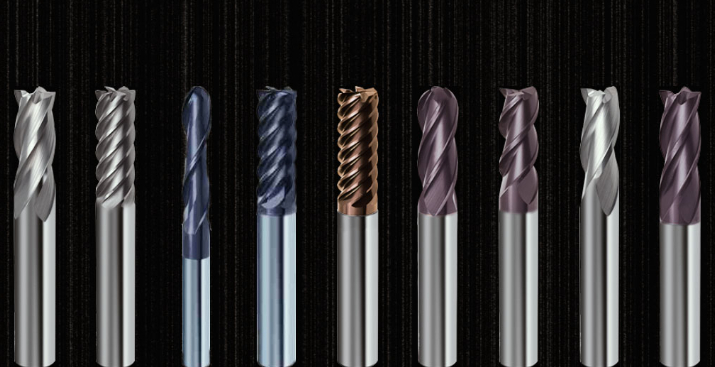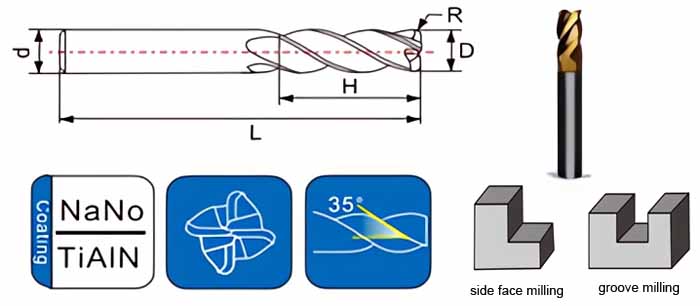Введение: Универсальные торцевые фрезы с 4 фланцами
4 фужера концевые фрезы незаменимые инструменты в мире обработки, известные своей способностью обеспечивать баланс агрессивного съема материала и гладкой поверхности. Их четыре режущие кромки, или флейты, обеспечивают повышенную стабильность и зазор для стружки, что делает их идеальными для широкого спектра применений в различных отраслях промышленности. В этом подробном руководстве рассматриваются особенности трех основных типов концевых фрез с четырьмя флейтами: Концевые фрезы с прямым хвостовиком, концевые фрезы с длинным плоским хвостовиком и круглые концевые фрезы с прямым хвостовикомИзучая их уникальные характеристики, применение и преимущества.

Понимание основ: Что такое концевая фреза с 4 флейтами?
Определение инструмента:
A 4-х флейцевая концевая фреза это вращающийся режущий инструмент с четырьмя спиральными режущими кромками, или флейтами, расположенными по спирали вдоль его корпуса. Эти канавки способствуют эффективному удалению материала, отводя стружку от зоны резания. Конструкция концевой фрезы позволяет выполнять как осевое, так и боковое резание, что делает ее универсальной для множества операций обработки.
Основные компоненты концевой фрезы с 4 фланцами:
- Режущие кромки: Четыре точно заточенные кромки, обычно изготовленные из твердого сплава или быстрорежущей стали, отвечают за резку заготовки.
- Флейты: Спиральные канавки, проходящие вдоль корпуса концевой фрезы, обеспечивают отвод стружки. Четыре канавки обеспечивают баланс между удалением стружки, чистотой поверхности и жесткостью инструмента.
- Хвостовик: Цилиндрическая часть концевой фрезы закрепляется в держателе инструмента фрезерного станка.
- Тело: В основной части концевой фрезы расположены флейты, соединяющие хвостовик с режущими кромками.
Изучение трех основных типов концевых фрез с 4 фланцами
1. Квадратные концевые фрезы с прямым хвостовиком: Рабочая лошадка для общей обработки
Концевые фрезы с прямым хвостовиком являются наиболее распространенным типом концевых фрез с 4 фланцами, характеризуются квадратным профилем резания и прямым хвостовиком. Они очень универсальны и широко используются для широкого спектра операций обработки, включая:
- Пазы и карманы: Создание прямоугольных пазов и карманов в заготовках.
- Профилирование: Обработка контуров и профилей на краях заготовок.
- Облицовка: Создание плоских поверхностей путем снятия материала с верхней поверхности заготовки.
2. Концевые фрезы с прямым хвостовиком и длинной плоской головкой: Точное достижение глубины
Концевые фрезы с прямым хвостовиком и длинной плоской головкойИзвестные также как концевые фрезы с большим вылетом, они специально разработаны для обработки глубоких полостей и элементов. Они имеют увеличенную длину резания и уменьшенный диаметр шейки, что обеспечивает большую досягаемость и жесткость при глубоком резании. Основные области применения включают:
- Обработка глубоких полостей: Создание глубоких карманов, пресс-форм и штампов с высокой точностью.
- Обработка стержней пресс-форм: Обработка сложных деталей и элементов в стержнях пресс-форм.
- Производство аэрокосмических компонентов: Производство сложных деталей с глубокими полостями и жесткими допусками.
3. Круглые концевые фрезы с прямым хвостовиком: Достижение плавных контуров и радиусов
Круглые концевые фрезы с прямым хвостовиком Имеют закругленный режущий профиль, позволяющий создавать плавные контуры, радиусы и галтели. Они обычно используются в тех случаях, когда необходимо получить более гладкую поверхность и снизить концентрацию напряжений, например:
- Контурная обработка: Создание плавных, текучих изгибов и профилей.
- Филе и радиусная обработка: Обработка закругленных углов и краев для уменьшения точек напряжения.
- Полировка плесени: Финишная обработка и полировка полостей пресс-формы для получения высококачественной поверхности.



Сравнительный анализ: Понимание различий
| Характеристика | Концевая фреза с прямым хвостовиком | Концевая фреза с прямым хвостовиком и длинной плоской головкой | Фреза с круглым торцом с прямым хвостовиком |
|---|---|---|---|
| Профиль резки | Квадрат | Квадрат | Круглый |
| Тип хвостовика | Прямой | Прямой | Прямой |
| Общая длина | Стандарт | Расширенный | Стандарт |
| Диаметр горловины | Стандарт | Снижение | Стандарт |
| Приложения | Общая обработка, пазы, карманы, профилирование, торцевание | Обработка глубоких полостей, обработка стержней пресс-форм, аэрокосмических компонентов | Обработка контуров, обработка галтелей и радиусов, полировка пресс-форм |
| Преимущества | Универсальные, широкодоступные, экономически эффективные | Увеличенный радиус действия, повышенная жесткость для глубоких пропилов | Гладкие контуры, уменьшенная концентрация напряжений |
| Ограничения | Ограниченный охват глубоких полостей | При чрезмерном выступе может быть подвержен прогибу. | Не подходит для квадратных углов и острых краев |
Применение в различных отраслях промышленности: Универсальность торцевых фрез с 4 фланцами
Удовлетворение разнообразных потребностей в обработке:
- Аэрокосмическая промышленность: Производство сложных компонентов с жесткими допусками, таких как детали двигателей, лопатки турбин и элементы конструкций.
- Автомобиль: Производство блоков цилиндров, головок блока цилиндров, деталей трансмиссии и других критически важных компонентов, требующих точности и долговечности.
- Производство медицинского оборудования: Создание имплантатов, хирургических инструментов и других медицинских изделий с высокой точностью и биосовместимостью.
- Изготовление пресс-форм: Обработка сложных полостей пресс-форм, стержней и деталей для различных отраслей промышленности, включая производство пластмасс, литье под давлением и литье под давлением.
- Общая обработка: Широко используется в механических мастерских и на производстве для выполнения различных задач, включая создание прототипов, ремонт и изготовление на заказ.
Выбор подходящей концевой фрезы с 4 фланцами: Основные соображения
Факторы, влияющие на выбор инструмента:
- Обрабатываемый материал: Для различных материалов требуются концевые фрезы с особыми свойствами, такими как твердость, износостойкость и покрытие.
- Тип операции обработки: Конкретная операция обработки, например, пазование, прорезка карманов или профилирование, будет определять соответствующую геометрию концевой фрезы.
- Глубина реза: Для глубоких полостей необходимы концевые фрезы с большим вылетом, обеспечивающие необходимый вылет и жесткость.
- Требования к чистоте поверхности: Выберите концевую фрезу с соответствующим количеством зубьев и геометрией для достижения требуемой чистоты поверхности.
- Возможности станков: Учитывайте скорость вращения шпинделя, мощность и жесткость фрезерного станка, чтобы обеспечить совместимость с выбранной концевой фрезой.
Почему вы выбираете TRUER для своих потребностей в концевых фрезах с 4 фланцами?
Сотрудничество с лидером в области прецизионной оснастки:
- Бескомпромиссное качество: Компания TRUER осуществляет строгий контроль качества на протяжении всего производственного процесса, обеспечивая исключительную производительность и долговечность инструмента.
- Экспертиза по конкретным приложениям: Наша команда опытных инженеров поможет вам выбрать оптимальную концевую фрезу с 4 фланцами для вашей конкретной задачи, максимизируя эффективность и результаты.
- Конкурентоспособные цены и своевременная доставка: TRUER предлагает конкурентоспособные цены и стремится оперативно доставлять заказы, сводя к минимуму время простоя и повышая производительность.
Часто задаваемые вопросы: Ответы на ваши вопросы о торцевых фрезах с 4 фланцами
1. Каковы основные преимущества использования концевой фрезы с 4 фланцами по сравнению с концевой фрезой с 2 фланцами?
Концевые фрезы с 4 фрезами обеспечивают повышенную стабильность, улучшенный отвод стружки и, как правило, более гладкую поверхность по сравнению с концевыми фрезами с 2 фрезами. Это делает их подходящими для более широкого спектра материалов и операций обработки, особенно при высоких усилиях резания.
2. В каких случаях следует выбирать концевую фрезу с квадратным хвостовиком, а не с круглым?
Выбирайте концевую фрезу с прямым хвостовиком и квадратным сечением для общих операций обработки, когда необходимо создать квадратные углы, пазы или карманы. При обработке контуров, радиусов или галтелей выбирайте круглые концевые фрезы с прямым хвостовиком, поскольку их закругленный профиль резания обеспечивает более гладкую поверхность и уменьшает концентрацию напряжений.
3. Каково значение уменьшенного диаметра шейки на концевой фрезе с прямым хвостовиком и длинной плоской поверхностью?
Уменьшенный диаметр шейки торцевой фрезы с прямым хвостовиком и длинной плоской головкой позволяет увеличить глубину обработки глубоких полостей, сохраняя при этом жесткость. Такая конструкция минимизирует отклонение инструмента и вибрацию, повышая точность и качество обработки поверхности при глубоком резании.
4. Каковы общие признаки износа концевой фрезы с 4 фланцами и как продлить срок службы инструмента?
К общим признакам износа относятся увеличение силы резания, ухудшение качества поверхности, чрезмерное выделение тепла, а также сколы или поломки режущих кромок. Чтобы продлить срок службы инструмента, используйте соответствующие параметры резания, эффективно применяйте охлаждающую жидкость, поддерживайте жесткую настройку и избегайте чрезмерного отклонения инструмента.
5. Какие факторы следует учитывать при выборе материала и покрытия для 4-х флейцевой концевой фрезы?
Учитывайте обрабатываемый материал, тип обработки и желаемый срок службы инструмента. Твердосплавные концевые фрезы, как правило, дороже, но обеспечивают превосходную твердость, износостойкость и высокотемпературные характеристики. Концевые фрезы из быстрорежущей стали более экономичны и подходят для обработки более мягких материалов. Покрытия, такие как TiN, TiCN и AlTiN, могут дополнительно увеличить срок службы инструмента, твердость и производительность.
Хотите купить высококачественные концевые фрезы с 4 флейтами по правильной цене? Нажмите здесь.




